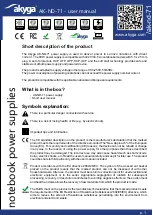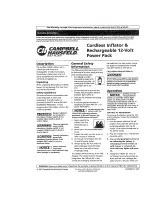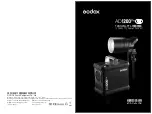
11
254 and 254OS Pneudraulic Installation Tools (HK1172)
Fill and Bleed
This section documents the “bleed-&-fill” procedure.
For
component identification, see
Figures 6–8.
REQUIRED EQUIPMENT
→
DEXRON®
III or equivalent
ATF
→
Shop air-line with 90–100 psi
(
6.2–6.9 bar
) max.
→
Air regulator
→
Fill Bottle Assembly (P/N
120337
, included with tool)
→
Fill Tool (P/N
112465
)
→
Large flat-blade screwdriver
→
Nose assembly or optional
stall nut (P/N
120824
)
→
Fasteners (optional)
PREPARATION
Install air regulator in the air-line and set the pressure to
20–40 psi (
1.4–2.8 bar
).
Add an approved hydraulic fluid to the fill point of the Fill
Bottle.
NOTE: Refill the tool only when the fluid level
drops below the red line on the reservoir housing; or
when the tool is rebuilt.
TO BLEED AND FILL THE TOOL
1. Screw Fill Tool into the reservoir plunger. Pull the
plunger into the reservoir housing and lock the Fill Tool
in full-forward position by tilting the handle (long side
touching tool) and locking it in place. (Figure 7)
2. Remove relief valve plug and check valve plug, and all
guides, springs, and balls, from ports in head. Re-insert
relief valve plug and sleeve. (Figure 7)
3. Screw the retaining/lock nut onto the head assembly,
and screw the stall nut onto the hydraulic piston.
Tighten to ensure full thread engagement.
NOTE: Back
off the retaining/lock nut until it engages the stall
nut. Verify that the hydraulic piston is full-forward
and locked with nut (and, optionally, with stall nut).
4. Connect the tool to the air source to seat the air piston
at the bottom of the air cylinder; then disconnect. Lay
tool on its side with reservoir fill port facing up.
5. Insert the fill bottle in the
check valve port. (Figure 8).
6. Connect the tool to the air
supply and cycle it 20–30
times; watch for air bubbles
escaping into the bottle. (Rock
the tool to free trapped air.)
NOTE: Do not allow air to
re-enter the tool. When
cycling the tool, hold the fill
bottle as shown in Figure 8
to prevent drawing in air.
7. When air bubbles stop accumulating in the fill bottle,
stop cycling the tool. Remove the bottle and replace the
reservoir fill plug.
8. Install the check valve ball, guide, and spring. Replace
the check valve plug.
9. Turn the tool so the front of the head faces you. Use a
3/32” Allen wrench to back out (approximately 1/2 turn
counterclockwise) the setscrew inside the relief valve
plug. (This ensures that the piston remains in the full-
forward position.) Remove the relief valve plug; insert
the ball, guide, sleeve, and spring, and then re-insert the
plug.
10. Unlock the Fill Tool and check the fluid level (Red Line
Indicator, Figure 7) in the reservoir housing. Cycle the
tool with stall nut attached and retaining or lock nut
locked in full-forward position (“dead stall”). If the fluid
level in the reservoir housing drops below the red line,
repeat the “fill” procedure as outlined below until the
fluid level is sufficient.
NOTE: This usually requires 3
or 4 repetitions.
a. Lock the Fill Tool into the reservoir plunger. Lay the
tool on its side and remove the reservoir fill plug.
b. Insert the fill bottle and add a few drops of fluid to
the reservoir; wait for air bubbles to escape, then
remove the fill bottle. (Push a pin or a scribe into the
reservoir fill port to check for trapped air bubbles.)
c. Replace the plug.
d. Unlock the Fill Tool, cycle the tool as in step 10, and
check the fluid level in the reservoir housing.
The reservoir fluid level may drop slightly. If so, repeat
these steps until, when the Fill Tool handle is touched,
it has no pressure against it and it drops out of the lock
position, and the fluid level in the reservoir housing
does not drop when the tool is cycled.
When the fluid level is sufficient, remove the Fill Tool
and stall nut. Install a nose assembly and pull several
fasteners to test function.
WARNING: Avoid contact with hydraulic
fluid. Hydraulic fluid must be disposed of in
accordance with local regulations. See MSDS
for hydraulic fluid shipped with tool.
CAUTION
: All fluid must be purged from
the tool before refilling. The tool stroke will
be diminished if the fluid is aerated. For
optimal performance, refill with the fluid
recommended in
Specifications
.
(Check Valve port)
Red line indicator
(Shown in LOCK position.)
Figure 7
Fill Bottle
shown in
Check
Valve port
Figure 8
WARNING: Air pressure must be set at
20–40 psi (
1.4–2.8 bar
) to prevent possible
injury from high-pressure spray. If the plug
is removed, the fill bottle must be in place
before cycling the tool.
Figure 6
120337 FIll Bottle Assy




































